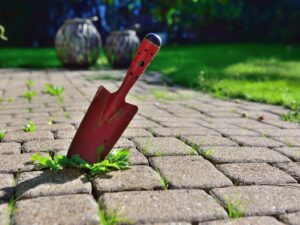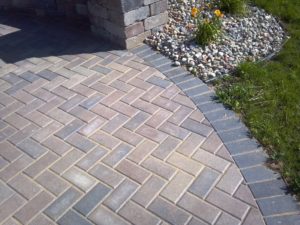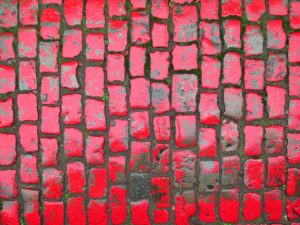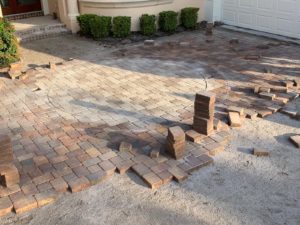A frequent question that arises when we talk about this product is functionality. People often wonder how interlocking pavers work, which is natural, especially for those who don’t work in this particular field.
The demand for pavers as a patio, walkway, and driveway flooring option has increased in recent years. But it’s not always clear what are the benefits that come with the product.

How Do Interlocking Pavers Work?
Interlocking pavers are most commonly made from cement or concrete and serve to simulate cobblestone pathways. What makes this product so unique is that it allows you to install pavers without the use of mortar.
The secret for these pavers to remain durable and new looking, even after years of abuse and weather, is precisely due to the interlocking feature. These pavers are installed leaving gaps in between each brick, and as soon as you fill these joint gaps with sand, it strengthens its entire structure.
The sand helps hold the pavers together by functioning as a binding agent that’s strong enough to keep everything in place, however flexible enough to accommodate heavy loads allowing just the necessary movement for the pavers not to crack.
How Much Do Interlocking Pavers Cost?
Because it’s a high-quality material, one may think it might be quite expensive. The truth is that it’s NOT. You’ll spend around $ 3 to $ 6 per square foot for most interlocking concrete pavers.
To determine the number of pavers per square foot:
- Multiply the length by the width. In a 4-by-8-inch paver, you have 32 square inches.
- Divide 144 – the number of square inches in a square foot, which you determine by multiplying 12 inches by 12 inches – by the number of square inches in the paver. In this case, 144 divided by 32 is 4 1/2 pavers per square foot.
- Multiply that number by the area square footage; if you have 100 square feet to fill, you need at least 450 pavers.
When installing pavers, it’s necessary to buy at least 5 percent more than you’ve estimated you need; 10 percent is best if you’ve never installed pavers before.
How Deep Should You Dig For Interlocking Pavers?
You have to determine the paver base depth by the type of stones you use and the variety of sand or gravel that you will lay under them.
Paver thickness is generally about 3- to 3 1/2-inches. Consequently, you need to dig a patio base depth of about 9 inches (22.86 cm) to accommodate any kind of brick. You will fill 5 inches (12.7 cm) of the hole with a base material, such as sand or gravel.
Digging is an essential part of the process; After all, the overall strength of your walkway (or patio) will heavily depend on suitable base preparation:
- Compact the soil in the hole, then fill it with gravel foundation.
- Place the gravel in layers and wet to help compact it.
- Fill the trench until you leave about 3.5 inches (8.89 cm) space for sand and pavers.
What Kind Of Sand Do You Use For Interlocking Pavers?
There are mainly two types of sands you can use for interlocking pavers: regular and polymeric.
Normal sand serves its purpose very well. It will fill gaps between pavers and help lock the individual blocks in place, so they don’t shift. If possible, use irregular, sharp-grained sand, as they have sharp edges and bind together better.
On the other hand, we have polymeric sand, which is excellent for interlocking pavers, although more expensive.
Usually, polymeric sand contains 85 – 90% quartz and crystalline silica, giving the product its notably binding power. When you wet this sand, it activates the polymers, which hardens the various components, effectively locking the pavers in place.
Once hardened, it won’t wash away with heavy rain or water from a hose, as regular loose sand would. This means you won’t have to worry about filling the joints frequently to keep them full.
Interlocking Pavers Maintenance
Our first maintenance recommendation for interlocking pavers is to finish the installation project by applying sealer on them. This substance will protect your investment effectively against any type of wear resulting from exposure (to the sun, rain, snow, etc.).
Also, sealing helps to prevent mold, moss, and hinders weed growth. Not to mention that the product also has proprieties that make it hard to absorb substances that could stain interlocking pavers, such as oil and sap.
Other maintenance and cleaning measures include daily sweeping and washing it weekly with hose water. For more difficult to remove dirt, you can also use a pressure washer.
Can I Install Interlocking Pavers Myself?
Yes, you can. Installing and maintaining interlocking pavers, it’s not hard but requires elevated care. For your investment to last many years and keep a beautiful appearance, it is necessary to follow the instructions, guidelines, and safe practices.
Still, if you count the amount of time you will be working on the project, the equipment costs (stone cutter, for example), the project can end up more expensive doing the work on your own than hiring a contractor to do it.
S&S Pavers has been proudly serving the counties of Manatee and Sarasota for the past 10+ years. From paver patio designs to installation and maintenance, if you live in Florida, don’t hesitate to give us a call.




